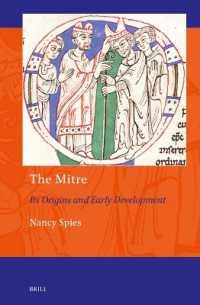- ホーム
- > 洋書
- > 英文書
- > Science / Mathematics
Full Description
For very high voltage or very high current applications, the power industry still relies on thyristor-based Line Commutated Conversion (LCC), which limits the power controllability to two quadrant operation. However, the ratings of self-commutating switches such as the Insulated-Gate Bipolar Transistor (IGBT) and Integrated Gate-Commutated Thyristor (IGCT), are reaching levels that make the technology possible for very high power applications.
This unique book reviews the present state and future prospects of self-commutating static power converters for applications requiring either ultra high voltages (over 600 kV) or ultra high currents (in hundreds of kA). It is an important reference for electrical engineers working in the areas of power generation, transmission and distribution, utilities, manufacturing and consulting organizations.
All topics in this area are held in this one complete volume. Within these pages, expect to find thorough coverage on:
modelling and control of converter dynamics;
multi-level Voltage Source Conversion (VSC) and Current Source Conversion (CSC);
ultra high-voltage VSC and CSC DC transmission;
low voltage high DC current AC-DC conversion;
industrial high current applications;
power conversion for high energy storage.
This text has a host of helpful material that also makes it a useful source of knowledge for final year engineering students specializing in power engineering, and those involved in postgraduate research.
Contents
Preface. 1 Introduction.
1.1 Early developments.
1.2 State of the large power semiconductor technology.
1.3 Voltage and current source conversion.
1.4 The pulse and level number concepts.
1.5 Line-commutated conversion (LCC).
1.6 Self-commutating conversion (SCC).
1.7 Concluding statement.
References.
2 Principles of Self-Commutating Conversion.
2.1 Introduction.
2.2 Basic VSC operation.
2.3 Main converter components.
2.4 Three-phase voltage source conversion.
2.5 Gate driving signal generation.
2.6 Space-vector PWM pattern.
2.7 Basic current source conversion operation.
2.8 Summary.
References.
3 Multilevel Voltage Source Conversion.
3.1 Introduction.
3.2 PWM-assisted multibridge conversion.
3.3 The diode clamping concept.
3.4 The flying capacitor concept.
3.5 Cascaded H-bridge configuration.
3.6 Modular multilevel conversion (MMC).
3.7 Summary.
References.
4 Multilevel Reinjection.
4.1 Introduction.
4.2 The reinjection concept in line-commutated current source conversion.
4.3 Application of the reinjection concept to self-commutating conversion.
4.4 Multilevel reinjection (MLR) - the waveforms.
4.5 MLR implementation - the combination concept.
4.6 MLR implementation - the distribution concept.
4.7 Summary.
References.
5 Modelling and Control of Converter Dynamics.
5.1 Introduction.
5.2 Control system levels.
5.3 Non-linearity of the power converter system.
5.4 Modelling the voltage source converter system.
5.5 Modelling grouped voltage source converters operating with fundamental frequency switching.
5.6 Modelling the current source converter system.
5.7 Modelling grouped current source converters with fundamental frequency switching.
5.8 Non-linear control of VSC and CSC systems.
5.9 Summary.
References.
6 PWM-HVDC Transmission.
6.1 Introduction.
6.2 State of the DC cable technology.
6.3 Basic self-commutating DC link structure.
6.4 Three-level PWM structure.
6.5 PWM-VSC control strategies.
6.6 DC link support during AC system disturbances.
6.7 Summary.
References.
7 Ultra High-Voltage VSC Transmission.
7.1 Introduction.
7.2 Modular multilevel conversion.
7.3 Multilevel H-bridge voltage reinjection.
7.4 Summary.
References.
8 Ultra High-Voltage Self-Commutating CSC Transmission.
8.1 Introduction.
8.2 MLCR-HVDC transmission.
8.3 Simulated performance under normal operation.
8.4 Simulated performance following disturbances.
8.5 Provision of independent reactive power control.
8.6 Summary.
References.
9 Back-to-Back Asynchronous Interconnection.
9.1 Introduction.
9.2 Provision of independent reactive power control.
9.3 MLCR back-to-back link.
9.4 Control system design.
9.5 Dynamic performance.
9.6 Waveform quality.
9.7 Summary.
References.
10 Low Voltage High DC Current AC-DC Conversion.
10.1 Introduction.
10.2 Present high current rectification technology.
10.3 Hybrid double-group configuration.
10.4 Centre-tapped rectifier option.
10.5 Two-quadrant MLCR rectification.
10.6 Parallel thyristor/MLCR rectification.
10.7 Multicell rectification with PWM control.
10.8 Summary.
References.
11 Power Conversion for High Energy Storage.
11.1 Introduction.
11.2 SMES technology.
11.3 Power conditioning.
11.4 The SMES coil.
11.5 MLCR current source converter based SMES power conditioning system.
11.6 Simulation verification.
11.7 Discussion - the future of SMES.
References.
Index.








